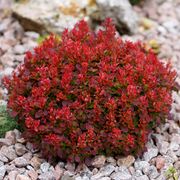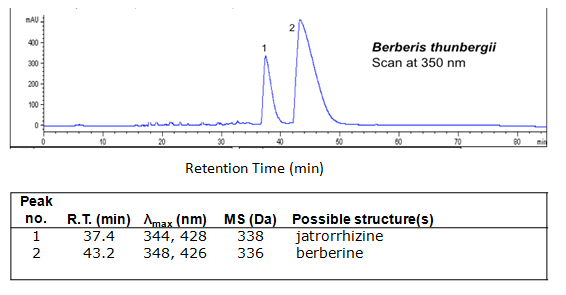Difference between revisions of "Berberis dye (berberis thunbergii) LC"
| (4 intermediate revisions by 2 users not shown) | |||
| Line 1: | Line 1: | ||
| − | [[File: | + | [[File:Berberisthunbergii.jpg|thumb|Lutin Rouge<br>Image Credit: Waitrose Gardens]] |
== Description == | == Description == | ||
| − | ''Berberis thunbergii'', | + | ''Berberis thunbergii'', is a dense, deciduous, spiny shrub which grows 0.6 to 2.5 m (2 to 8 ft) high. The plant is also called the Japanese barberry, Thunberg's barberry, or red barberry. It is a species of Berberis, native to Japan and eastern Asia, widely naturalized in China and in North America. |
== Historical importance == | == Historical importance == | ||
| Line 14: | Line 14: | ||
== Analytical instrumentation and procedures == | == Analytical instrumentation and procedures == | ||
| + | HPLC-DAD-MS analysis was performed with an Agilent 1100 liquid chromatography system consisting of an automatic injector, a gradient pump, a HP series 1100 DAD, and an Agilent series 1100 VL on-line atmospheric pressure ionization electrospray ionization mass spectrometer. Separations were done on a Vydac 214TP52 analytical column (2.1 mm diameterX250 mm; 5-ím particle size). The column was eluted at a flow rate of 0.2 mL/min with a tertiary gradient of water (A),acetonitrile (B), and 1% (v/v) aqueous formic acid (C) with the following elution program: 0 min, 90% A, 5% B, 5% C; 0-55 min, a linear gradient to 35% A, 60% B, 5% C; 55-60 min, a linear gradient elution to 15% A, 80% B, 5% C; 60-62 min, isocratic elution at 15% A, 80% B, 5% C; 62-70 min gradient elution to 90% A, 5% B, 5% C; and reequilibration with the latter solvent for 15 min. The mass spectrometer was run both in the negative and positive ion mode. | ||
== Chromatograms == | == Chromatograms == | ||
Latest revision as of 12:36, 29 May 2020
Description
Berberis thunbergii, is a dense, deciduous, spiny shrub which grows 0.6 to 2.5 m (2 to 8 ft) high. The plant is also called the Japanese barberry, Thunberg's barberry, or red barberry. It is a species of Berberis, native to Japan and eastern Asia, widely naturalized in China and in North America.
Historical importance
Summary of results
Analytical instrumentation and procedures
HPLC-DAD-MS analysis was performed with an Agilent 1100 liquid chromatography system consisting of an automatic injector, a gradient pump, a HP series 1100 DAD, and an Agilent series 1100 VL on-line atmospheric pressure ionization electrospray ionization mass spectrometer. Separations were done on a Vydac 214TP52 analytical column (2.1 mm diameterX250 mm; 5-ím particle size). The column was eluted at a flow rate of 0.2 mL/min with a tertiary gradient of water (A),acetonitrile (B), and 1% (v/v) aqueous formic acid (C) with the following elution program: 0 min, 90% A, 5% B, 5% C; 0-55 min, a linear gradient to 35% A, 60% B, 5% C; 55-60 min, a linear gradient elution to 15% A, 80% B, 5% C; 60-62 min, isocratic elution at 15% A, 80% B, 5% C; 62-70 min gradient elution to 90% A, 5% B, 5% C; and reequilibration with the latter solvent for 15 min. The mass spectrometer was run both in the negative and positive ion mode.
Chromatograms
Identified compounds
| Compound | RT (min.) | MW | UV/vis | Other | |
|---|---|---|---|---|---|
| Jatrorrhizine | 37.4 | 337 | 344,428 | Comments here | |
| Berberine | 43.2 | 335 | 348,426 |
References
[1] [2] [3]

